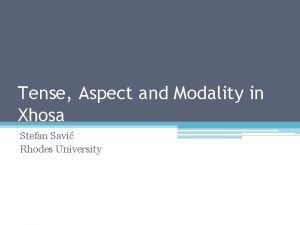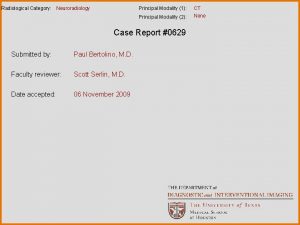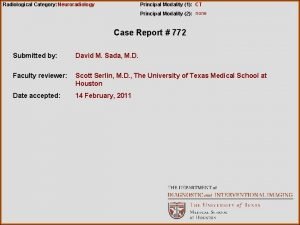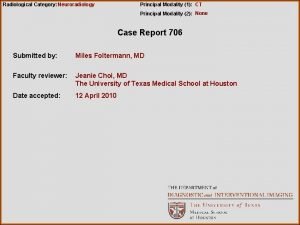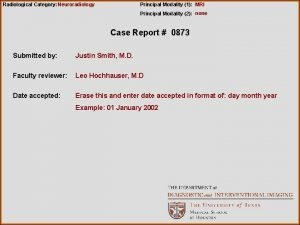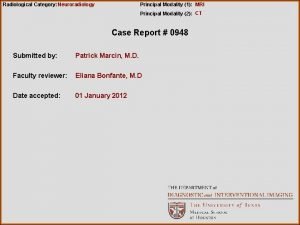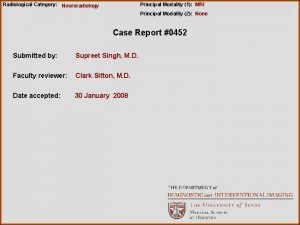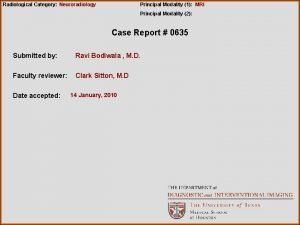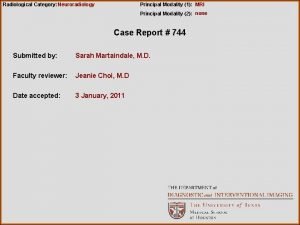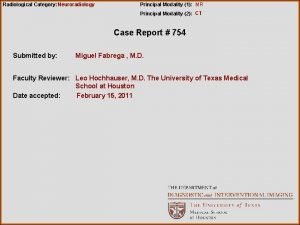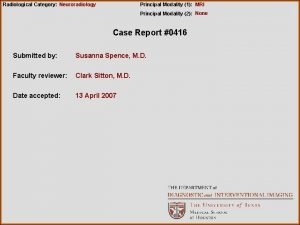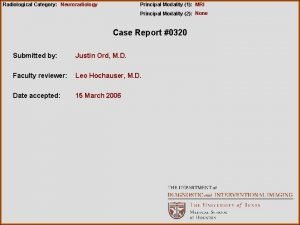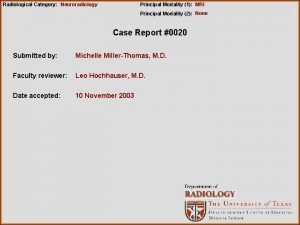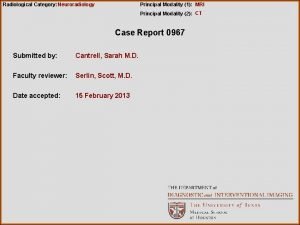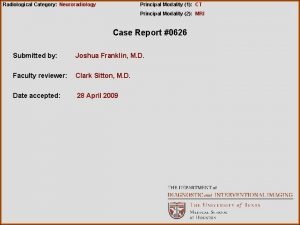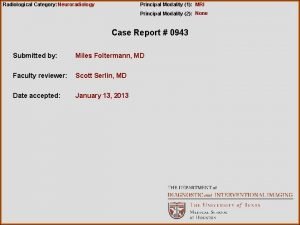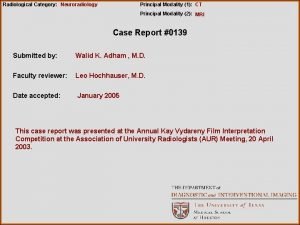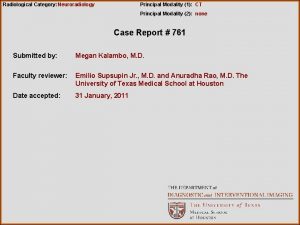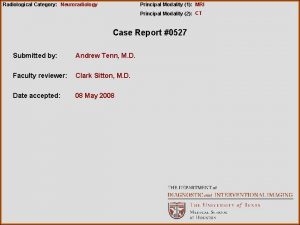Principal Modality 1 CT Radiological Category Neuroradiology Principal






















- Slides: 22

Principal Modality (1): CT Radiological Category: Neuroradiology Principal Modality (2): None Case Report #0526 Submitted by: Andrew Tenn, M. D. Faculty reviewer: Richard Fremaux, M. D. Date accepted: 16 April 2008

Case History 32 y. o. female presents today here for follow up of otitis media. She was told she had a something there that may need f/u with ent. She has felt throbbing, feels like water for several months.

Case History On physical exam of ears - normal left TM, abnormal right TM exam - bulging, cystlike structure in tympanic membrane, no erythema

Radiological Presentations

Radiological Presentations

Radiological Presentations

Radiological Presentations

Radiological Presentations

Radiological Presentations

Radiological Presentations

Radiological Presentations

Radiological Presentations

Radiological Presentations

Test Your Diagnosis Which one of the following is your choice for the appropriate diagnosis? After your selection, go to next page. • A. Glomus tympanicum • B. Cholesteatoma • C. Facial nerve schwannoma • D. Persistent Stapedial artery

Findings and Differentials Findings: Soft tissue 5 mm nodule arising from the cochlear promontory in the middle ear. Clearly separated from facial nerve (its horizontal segment can be seen on the first several axial slices running anteromedial to posterolat, just under the lateral semicircular canal). Scutum intact, epitympanic recess clear. Differentials: • A. Glomus tympanicum • B. Cholesteatoma • C. Facial nerve schwannoma • D. Persistent stapedial artery

Discussion • Glomus Tympanicum typically presents as pulsatile tinnitis in a middle age female (vascular lesions=pulsatile). It arises from glomus bodies along the tympanic branch of CN IX, called Jacobson’s nerve. On MRI it is an enhancing vascular lesion. It classically arises from the cochlear promontory (arrows below). When large, it tends to engulfs bone but does not erode it. Coronal Axial

Discussion • Acquired Cholesteatomas are erosive collections of keratinous debris that result from long standing otomastoiditis. Bone erosion and expansion are classic. They arise from the pars flaccida (upper tympanic membrane) and erode the scutum and invade Prussak’s space- the space in the epitympanic recess lateral to the ossicles. In this case, the scutum(lower arrow) and Prussak’s space (upper arrow) are normal.

Discussion • Facial Nerve Schwannomas can arise in any segment of the facial nerve. They will typically expand the intraosseous canal. These images demonstrate normal sized IAC and no expansion of the intraosseus canal (arrow) containing the tympanic segment (which runs directly under the horizontal semicircular canal.

Discussion • Persistent Stapedial Artery is is an aberrant persistence of the fetal connection b/t the ECA and ICA. Findings are: absent foramen spinosum (the PSA supplies the middle meningeal artery in place of the internal maxillary artery), and a soft tissue prominence near the horizontal segment of the facial nerve. There is a common association to aberrant ICA, which can run within the middle ear. In this case, the foramen spinosum (arrow) is present, and the bone margins of the carotid canal are intact.

Discussion • REFERENCES: • Grossman RI, Yousem DM (2003). Neuroradiology: The Requisites, 2 nd Ed. Philadelphia, Elsevier Inc. Silbergleit R et. Al. The Persistent Stapedial Artery. AJNR 2000; 21: 572 -577

Diagnosis Glomus Tympanicum

References Grossman RI, Yousem DM (2003). Neuroradiology: The Requisites, 2 nd Ed. Philadelphia, Elsevier Inc. Silbergleit R et. Al. The Persistent Stapedial Artery. AJNR 2000; 21: 572 -577
 Ohsu neuroradiology
Ohsu neuroradiology Erate category 2 eligible equipment
Erate category 2 eligible equipment National radiological emergency preparedness conference
National radiological emergency preparedness conference Radiological dispersal device
Radiological dispersal device Tennessee division of radiological health
Tennessee division of radiological health Center for devices and radiological health
Center for devices and radiological health Cardinality and modality
Cardinality and modality Modality erd
Modality erd Modality in software engineering
Modality in software engineering Modality microsoft services
Modality microsoft services Epistemic modality
Epistemic modality Imaging modality
Imaging modality What is modality in statistics
What is modality in statistics Stefan savi
Stefan savi Modality in software engineering
Modality in software engineering Deontic and epistemic modality exercises
Deontic and epistemic modality exercises Modality in software engineering
Modality in software engineering Cardinality and modality in database
Cardinality and modality in database Modality
Modality Medium modality
Medium modality Pacs modality workstation
Pacs modality workstation Swd modality
Swd modality Exteroceptors
Exteroceptors













